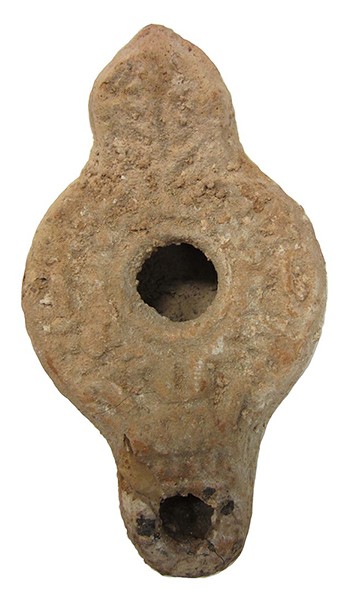Middle Eastern Oil Lamp
 Although we do not know its specific place of origin, this oil lamp is a typical product of the Late Antique eastern Mediterranean or Middle East. It dates to between the 4th and 7th century CE. It is about four inches long and would easily fit in your hand. To use the oil lamp, oil was poured in the main compartment through the larger central hole. The nozzle originally held a cloth or rope wick. The charring and abrasion around the nozzle on this lamp show that it was used.
Although we do not know its specific place of origin, this oil lamp is a typical product of the Late Antique eastern Mediterranean or Middle East. It dates to between the 4th and 7th century CE. It is about four inches long and would easily fit in your hand. To use the oil lamp, oil was poured in the main compartment through the larger central hole. The nozzle originally held a cloth or rope wick. The charring and abrasion around the nozzle on this lamp show that it was used.
Oil lamps had many uses in the ancient world. They were an everyday source of portable light, similar to a candle or flashlight. They were also used in a variety of religious ceremonies. Archaeologists often find oil lamps like this one in ancient graves. During funeral rites, the bereaved placed them in burials the same way people now put flowers on gravestones.
Ancient oil lamps like this one were made by pressing wet clay into two carved-stone molds, then joining the top and bottom halves before firing the piece. Lamps frequently bear decorative stamp designs that were carved into the stone molds. Potters often copied the decor on imported pieces, which helped to transmit common motifs like the dot-rosette base and palm-leaf handle shown here throughout the Mediterranean world.
This lamp is featured in the virtual exhibit The Private Lives of Pots. Research for this post was completed by David Mulder (’20) who curated the exhibit.

